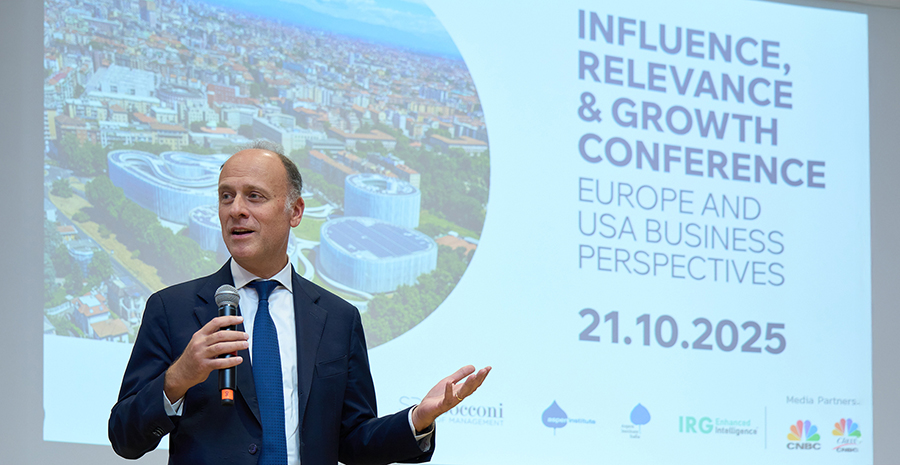From space research an answer to the climate crisis
Space technology to fight climate change. A hope that is based on current premises and gives us a glimpse of possible solutions to the main global threat, the climate crisis. This is the key to understanding SDA Bocconi’s SEE Lab (Space Economy Evolution) Annual Conference dedicated to the theme, and this year significantly part of Milan’s Pre-Cop, the preparatory meeting for the UN Climate Change Conference (Cop26).
Participants in the meeting were welcomed by SDA Bocconi’s Dean Beppe Soda. He recalled the late Andrea Sommariva, SEE Lab’s Director, who recently passed away: “Andrea’s passion and enthusiasm were contagious, he always saw the positive side of things, and even during the course of his illness he was always optimistic. As a researcher, he was able to adopt a multidisciplinary approach; he was a visionary, not only while looking at the present but also in imagining future scenarios.” Imagining and implementing new and effective solutions to stop climate change in an increasingly near future is also what the younger generations are asking for.
It was UNOOSA (United Nations Office for Outer Space Affairs) Director Simonetta Di Pippo who was tasked with opening the meeting. She got straight to the heart of the matter: How can space activities contribute to fighting climate change? UNOOSA is launching Space4ClimateAction, an initiative for the UN to connect all the valuable projects that go in this direction. “At present, space technology is still underused,” Di Pippo maintains. “Satellites observe the Earth and can help monitor climate variables, and their data allows for a clearer understanding of climate change.” Space4ClimateAction is in line with the SDGs, the UN’s Sustainable Development Goals, and in particular with SDG 13 - Climate action. Its operational plan aims to promote awareness and use of space technology to achieve climate goals by supporting the players’ ability to design, implement, monitor and assess, providing technical and financial support, coordinating international cooperation and encouraging participation by the private sector.
Today, satellites play a key role in achieving sustainable development goals. World Secure Foundation’s Space Applications Programs Director Krystal Azelton and Mary-Ann Kutny, International Affairs for the National Environmental Satellite Service Deputy Director at the US National Oceanic and Atmospheric Administration (NOAA), both focused the discussion on this point, underlining that orbiting satellites are more and more numerous, can provide unequivocal evidence of climate change on Earth and allow policy makers to face its consequences, manage risks and improve the resilience of the planet. To do so, we need to ensure “data democracy”, that is to say that data is available (findable, accessible and interoperable) to all interested actors, as well as foster cooperation in collecting and managing data between private players and public institutions.
But space technology can go beyond data collection. This is what Andrea Biancardi, Energy Transition Lecturer at SDA Bocconi, explained, introducing what was possibly the main topic of the meeting: Space-Based Solar Power (SBSP), i.e. the possibility of capturing energy from the sun on a high Earth orbit and transferring it to the ground. Is this feasible? Biancardi started from data: what is being done today is not enough to keep global warming within the limits of the 2015 Paris agreement. Three quarters of all carbon dioxide emissions are generated by the energy sector: we need to change the ways we produce, transport and consume energy on the planet. SBSP would bring considerable benefits by providing clean and constant energy without incurring the disadvantages associated with the intermittency of terrestrial renewables.
John Mankins, the top SBSP expert globally and International Astronautical Federation’s Space Energy Committee President, and George Sowers, Space Resources Professor at the Colorado School of Mines, talked with Center for Space Policy and Strategy’s Karen L. Jones, who moderated the first panel. They addressed the technical feasibility of SBSP. “It is much easier than recreating the sun on Earth,” said Mankins comparing this technology to nuclear fusion. The cost of launch and orbit equipment can be reduced by over 90% thanks to the SPS Alpha model: small low-cost modular equipment, mass-produced, shipped into space on board low-cost reusable vectors and assembled in orbit. If we started investing today, we could have an active plant, producing up to 2 gigawatts, by the beginning of the next decade.
The following step is Moon-based SBSP, Sowers continues, quoting John Marburger: “Anything that can be made with lunar raw materials at a cost comparable to manufacturing it on Earth has a huge advantage in terms of overall costs compared to what needs to be sent into orbit from Earth.” And on the Moon you virtually have all that’s needed: metals, silicon, rare earths, potassium, phosphorous, helium and ice, which can be used to produce hydrogen as a propellant. On top of that, in the absence of an atmosphere, the mass that solar energy satellites need to have in space would be half that of a satellite launched from Earth, with a consequent reduction of costs for raw materials, development, manufacturing and launch. International cooperation and public-private partnerships will be key for these developments.
Is this future also available for our country? During the following panel, composed of representatives from important Italian companies in the industry, moderator Roberto Vittori, an officer of the Italian Air Force and ESA astronaut, stressed the timeline, with a look at the present and the next 10-20 years. According to Massimo Comparini, Thales Alenia Space’s CEO, observation of Earth from space is a rapidly evolving sector, and Italy and Europe are key contributors: “Thales Alenia Space is already working on lunar installation projects, but when it comes to energy the low Earth orbit (LEO) will be strategic in the near future and SBSP is part of our society’s roadmap.” Sitael, represented by its Sales Director Marzia Migliorelli, is collaborating on the Corpernicus European satellite project and the new PLATiNO platform to expand the field of data that can be obtained from space observation. “The most important added value of satellites in fighting climate change is that they allow us to see the Earth from a different point of view,” she said. Telespazio’s CEO Luigi Pasquali shared her view: “We, for instance, are collaborating with ESA on coastal erosion monitoring projects and are working on the contribution satellites can give for more efficient use of water and fertilizers in precision agriculture. The future is to go beyond monitoring and measuring, increasing our ability to predict problems and provide solutions in advance.” Giulio Ranzo, CEO of Avio, focused on vectors, defining them “taxis” to carry space structures into orbit: “We are trying to be ever more flexible, not only about the characteristics of the satellites we are able to launch but also our ability to reach the different orbits. Solar energy will be crucial to exploring deep space, when missions become longer and longer.” At the end of the panel, Roberto Vittori posed a challenge: Seen the skills on the table, why not make the SBSP an Italian proposal at a European level?
Will space make the G20 agenda? Italian Space Agency Director Giorgio Saccoccia opened his final contribution with this wish. The climate emergency demands new and bold perspectives and “once again SEE Lab’s work highlighted the fact that space can be useful for our planet, help humanity and generate prosperity.” At the heart of all this is scientific research, the essential prerequisite to any technological solution. “We still need plenty of pure research and development,” Saccoccia said. “Not only applications but also R&D for services to support activities on Earth. For this reason, some Recovery Fund resources should go to researching innovative ways to get the most out of space technology.”
SDA Bocconi School of Management
AI and the future of management: between ...

Influence, Relevance & Growth: Addressing the ...




